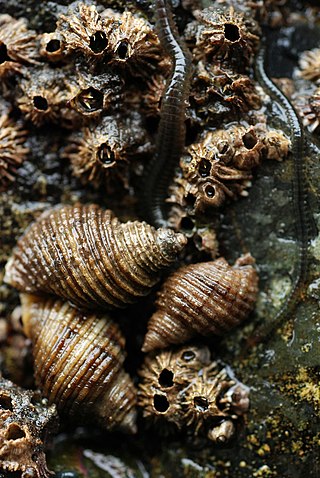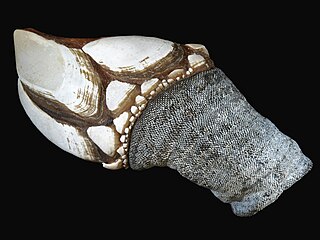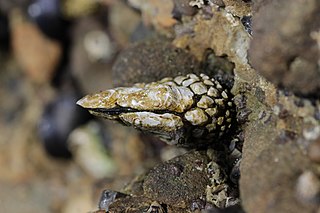Related Research Articles

Thoracica is an infraclass of crustaceans which contains the most familiar species of barnacles found on rocky coasts, such as Semibalanus balanoides and Chthamalus stellatus. They have six well-developed limbs, and may be either stalked or sessile. The carapace is heavily calcified. The group includes free-living and commensal species.

Thecostraca is a class of marine invertebrates containing over 2,200 described species. Many species have planktonic larvae which become sessile or parasitic as adults.

The Balanidae comprise a family of barnacles of the order Balanomorpha. As a result of research published in 2021 by Chan et al., the members of the family Archaeobalanidae were merged with this family.

The Chthamalidae are a family of chthamaloid barnacles, living entirely in intertidal/subtidal habitats, characterized by a primary shell wall of eight, six, or four plates, lacking imbricating plate whorls, and either membraneous or more rarely calcareous basis. They are not found below immediate subtidal habitats, and more likely are found in the highest tier of shallow-water barnacle fauna. They can be found in the most rigorous wave-washed locations, and some species are found in the surf zone above high tide mark, only receiving water from wave action at high tide.

Sessilia is an unranked clade of barnacles, comprising the barnacles without stalks, or acorn barnacles. They form a monophyletic group and are probably derived from stalked or goose barnacles. Sessilia is divided into two orders. The Verrucomorpha contain two families, Verrucidae and Neoverrucidae, and the remaining 14 families are in the order Balanomorpha.
In the past, Lernaeodiscidae has been considered a family of barnacles. Research published in 2021 by Chan et al. resulted in the genera of Lernaeodiscidae being merged with that of Peltogastridae, which now contains the members of both families. As an exception, the species Triangulus galatheae was moved to the genus Paratriangulus in the family Triangulidae.
In the past, Archaeobalanidae has been considered a family of barnacles of the order Sessilia. Research published in 2021 by Chan et al. resulted in the genera of Archaeobalanidae being merged with that of Balanidae, which now contains the members of both families. In the same work, Sessilia was not retained as an order of barnacles.

Semibalanus is a genus of barnacles, comprising four species. It is the only genus in the subfamily Semibalaninae.
Pseudoctomeris sulcatus is a species of barnacle, the only member of the genus Pseudoctomeris. It has an eight-plated shell wall with the rostrum partially fused with adjacent rostrolatera. The suture lines are visible only from the inside, thus in exterior view, the shell appears to have six wall plates. The basis is calcareous. Opercular plates are higher than wide, and not deeply articulated. These features and others show strong relationship to family Pachylasmatidae, and taxonomic revision of Pachylasmatidae has resulted in the transfer of Pseudoctomeris from Chthamalidae to Pachylasmatidae.
The Catophragmidae are a family of barnacles in the superfamily Chthamaloidea with eight shell wall plates, surrounded by several whorls of imbricating plates. The basis is membranous.
In the past, Euraphiinae has been considered a subfamily of barnacles of the family Chthamalidae. Research published in 2021 by Chan et al. resulted in the genera of the three subfamilies Euraphiinae, Chthamalinae, and Notochthamalinae being assigned directly to the family, without subfamily groupings, and this subfamily is no longer used.
In the past, Platylepadidae has been considered a family of barnacles of the order Sessilia. Research published in 2021 by Chan et al. resulted in the genera of Platylepadidae being merged with that of Balanidae, except Stephanolepas which was moved to Chelonibiidae. In the same work, Sessilia was not retained as an order of barnacles.

Pyrgomatidae is a family of barnacles belonging to the order Balanomorpha.

Scalpellomorpha is an order of acorn barnacles in the class Thecostraca. There are about 11 families in 3 superfamilies and more than 450 described species in Scalpellomorpha.
In the past, Koleolepadidae has been considered a family of barnacles with a single genus, Koleolepas. Research published in 2021 by Chan et al. resulted in Koleolepas being moved to the family Heteralepadidae. The family Koleolepadidae is not longer active.
Iblidae is a family of crustaceans belonging to the order Iblomorpha. There are two genera in the family, each with its own subfamily.
Lithoglyptida is an order of barnacles in the class Thecostraca. There are 2 families and more than 40 described species in Lithoglyptida.
Iblomorpha is a small order of barnacles in the class Thecostraca. There are only two families and about eight described species in Iblomorpha. In this group we find barnacles that use calcium phosphate in their shell, and species that protect themselves against predators with poison.
Eolepadomorpha is an extinct order of barnacles in the class Thecostraca. There are 2 families and about 14 described species in Eolepadomorpha.

Pollicipedomorpha is an order of pedunculated barnacles in the class Thecostraca. There are 3 families and more than 30 described species in Pollicipedomorpha.
References
- ↑ Chan, Benny K. K.; Dreyer, Niklas; Gale, Andy S.; Glenner, Henrik; et al. (2021). "The evolutionary diversity of barnacles, with an updated classification of fossil and living forms". Zoological Journal of the Linnean Society. 193 (3): 789–846. doi: 10.1093/zoolinnean/zlaa160 . hdl: 11250/2990967 .